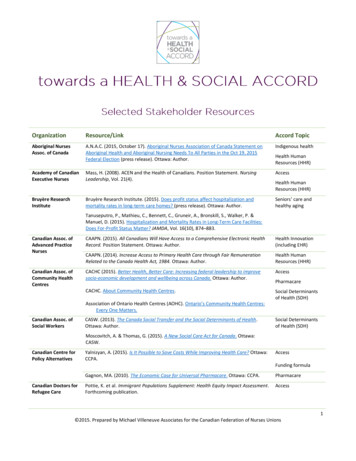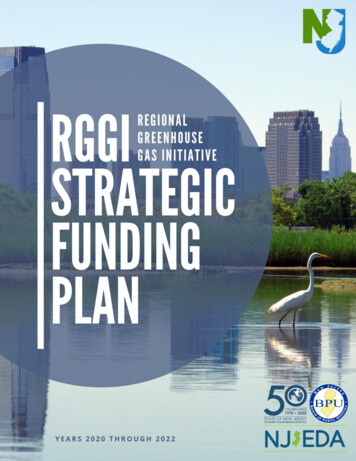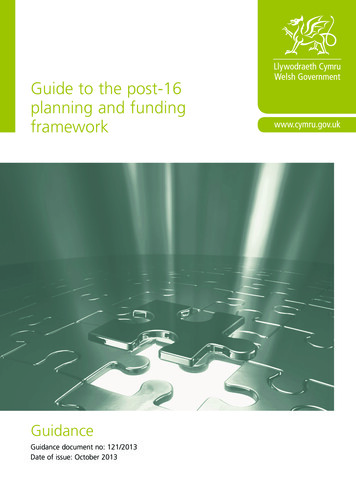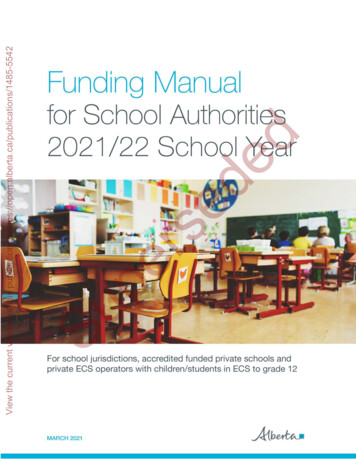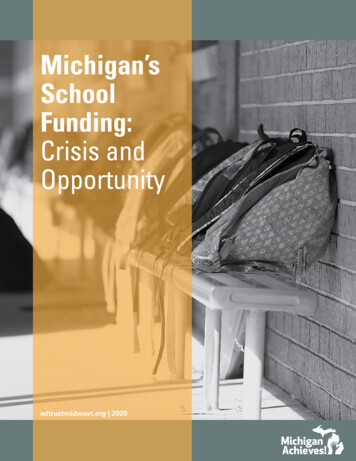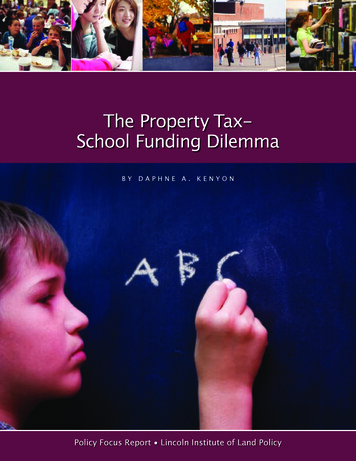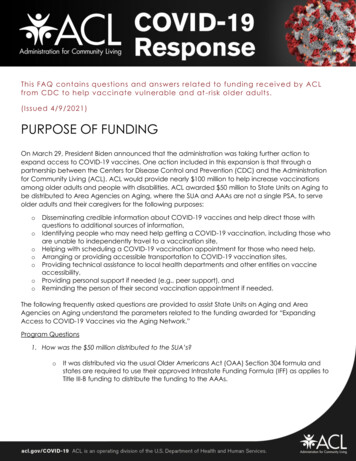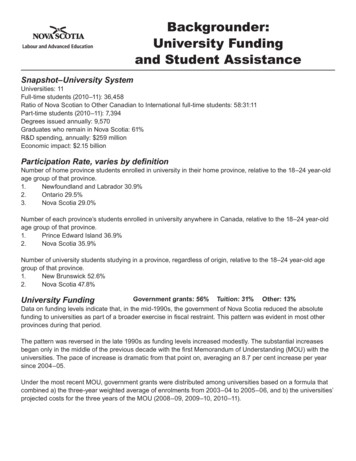
Transcription
Backgrounder:University Fundingand Student AssistanceSnapshot–University SystemUniversities: 11Full-time students (2010–11): 36,458Ratio of Nova Scotian to Other Canadian to International full-time students: 58:31:11Part-time students (2010–11): 7,394Degrees issued annually: 9,570Graduates who remain in Nova Scotia: 61%R&D spending, annually: 259 millionEconomic impact: 2.15 billionParticipation Rate, varies by definitionNumber of home province students enrolled in university in their home province, relative to the 18–24 year-oldage group of that province.1.Newfoundland and Labrador 30.9%2.Ontario 29.5%3.Nova Scotia 29.0%Number of each province’s students enrolled in university anywhere in Canada, relative to the 18–24 year-oldage group of that province.1.Prince Edward Island 36.9%2.Nova Scotia 35.9%Number of university students studying in a province, regardless of origin, relative to the 18–24 year-old agegroup of that province.1.New Brunswick 52.6%2.Nova Scotia 47.8%University FundingGovernment grants: 56%Tuition: 31%Other: 13%Data on funding levels indicate that, in the mid-1990s, the government of Nova Scotia reduced the absolutefunding to universities as part of a broader exercise in fiscal restraint. This pattern was evident in most otherprovinces during that period.The pattern was reversed in the late 1990s as funding levels increased modestly. The substantial increasesbegan only in the middle of the previous decade with the first Memorandum of Understanding (MOU) with theuniversities. The pace of increase is dramatic from that point on, averaging an 8.7 per cent increase per yearsince 2004–05.Under the most recent MOU, government grants were distributed among universities based on a formula thatcombined a) the three-year weighted average of enrolments from 2003–04 to 2005–06, and b) the universities’projected costs for the three years of the MOU (2008–09, 2009–10, 2010–11).
University ExpendituresUniversity Chart of Accounts Line Items ( 000), 2010-11 BudgetRevenuesBase Operating GrantOther Provincial FundingBursaryTotal Tuition RevenueOtherTotal RevenuesBudget DriversFaculty SalariesOther SalariesBenefitsUtilitiesInsuranceLibrary CollectionsDebt Servicing CostsFinancial Aid to StudentsExternally Contracted ServicesFacilities RenewalTechnologyOtherTotalYearly Cost Increase 348,309 32,450 26,724 230,217 95,847 733,54847.5%4.4%3.6%31.4%13.1% 256,592 176,805 76,696 30,238 2,867 13,412 15,734 38,119 25,860 21,364 11,194 65,936 734,817 .5%9.0%TuitionAverage Undergraduate Tuition in Nova Scotia 2010--2011NationalNova ScotiaOut of ProvinceBlendedAverage Student in NS Students Tuition(StatsCan) 5138 5130 6152 5495Average UndergraduateTuition Increase in 2011-2012Nova Scotia Out of ProvinceStudent in NS Student 154 185In the six years of the last two MOUs, Nova Scotia went from having the highest average student tuition to being 8 below the national average for Nova Scotian students in Nova Scotian universities.2006–07: Federal Infrastructure Trust Fund money was directed to a one-time reduction in tuition for NovaScotia students studying in Nova Scotia ( 440 for full-time students; 220 for part-time students).2007–08: One-time 500 tuition reduction for Nova Scotia students; an amendment in the MOU froze tuition inthe third year.
2008–09: Second MOU continued the tuition freeze and introduced a 761 bursary for Nova Scotia students inNova Scotia (Nova Scotia University Student Bursary Trust).2009–10: Tuition frozen and the bursary for Nova Scotia students at Nova Scotia universities rose to 1,022.2010–11: Tuition frozen and the bursary for Nova Scotia students at Nova Scotia universities rose to 1,283.For the first time, out of province Canadian students at Nova Scotia universities received a 261 bursary.The Nova Scotia University Student Bursary Trust cost the province 29,057,966.Student Assistance and DebtBetween 1990 and 2008, the average student debt in Nova Scotia, at the time of repayment, increased from 7,660 to 24,387 ( 218%). In constant dollars there was an increase of 119 per cent (from 7,660 to 16,749).A spike in debt after 1992 followed the elimination of the Nova Scotia Bursary Program, which provided thefull Nova Scotia student loan portion as a non-repayable bursary. From 1992 on, all student assistance wasrepayable loans. Eliminating the bursary program and rising tuition left students in Nova Scotia with the highestdebt levels in the country.In 2008, there was a slight decrease in debt as a result of Nova Scotia’s tuition reduction measures.In 2008, Nova Scotia began lending directly to students, reducing the interest rate by two percentage points. A20 per cent non-repayable grant was introduced, along with a grant for students with dependents. A repaymentassistance program and a payment deferral program were introduced.Nova Scotia’s current student assistance program still leaves students with significant unmet need and thesecond-highest level of repayable loans in the country.Consultation on Student AssistanceYesterday, Labour and Advanced Education received the results of its recent consultation on student assistance. While the results are just starting to be interpreted, six key themes emerged. These are a need to: cap debt for all borrowers provide more financial assistance by increasing the loan limit give more up-front, non-repayable grants have simpler process and better communication with student loan applicants and holders exclude parental and spousal income in needs assessments, and improve the graduate retention rebate program.What is the Province doing?University Funding: Grants to universities will decrease four per cent in 2011-12. We will negotiate future years’decreases with the institutions.Tuition: We will protect students by limiting tuition increases to three per cent. This is comparable to historictuition increases across Canada, and will keep our tuition levels around the national average.Rationale: These initiatives recognize the contribution that universities make to our economy and to our society. They are consistent with the Expenditure Management Initiative across government. As well, they areconsistent with the O’Neill recommendations.Student Debt: We will cap student debt at a level comparable to other provinces.
Section 2: Overview of the Nova Scotia University SystemFigure 2.4 University Funding, Current Dollars, 1990-91 to 2010-11 350Second mou349 330317 Funding (millions) 310 290289 first mou 270259 250236 230224 212 2122004-05 2003-04212 209203 195 190 201 201 2002-03 210212 2001-02209 194 190 182183 175 92-931991-921990-91 170Source: Higher Education Branch, NS Department of EducationFigure 2.5 University Funding, Constant (1990) Dollars, 1990-91 to 2010-11 240230 230Second mouFunding (millions) 220 210214 209 201 198 200198 194 190first mou186 182 180175 170169 160 161 160159 161 156158 157 152 164 159 Source: Higher Education Branch, NS Department of 990-91 15023
Nova Scotia Tuition Reduction to National Average: 2005‐06 to 2010‐11 8,000NS tuition, with reductionsNational Average 7,656NS tuiton, no intervention 7,500All Canadian Students Studying in Nova Scotia 7,369 7,092 7,000 6,826 6,570 6,500 6,323 6,422 6,000 6,110 5,877 5,982 5,752 5,936 5,495 5,500 5629 5,629 5,387 5,000 5,130 5,138 4,942 4,747 4,500 4,558 4,400 4,211 Note: The 2009-10 tuition amounts differ from those in the O'Neill report as a result of a revision of the data by Statistics Canada. The 2010-11numbers differ as the result of replacing the projections used in the O'Neil report with actual data from Statistics Canada.2010‐11
full Nova Scotia student loan portion as a non-repayable bursary. From 1992 on, all student assistance was repayable loans. Eliminating the bursary program and rising tuition left students in Nova Scotia with the highest debt levels in the country. In 2008, there was a slight decrease in debt as a result of Nova Scotia's tuition reduction .

